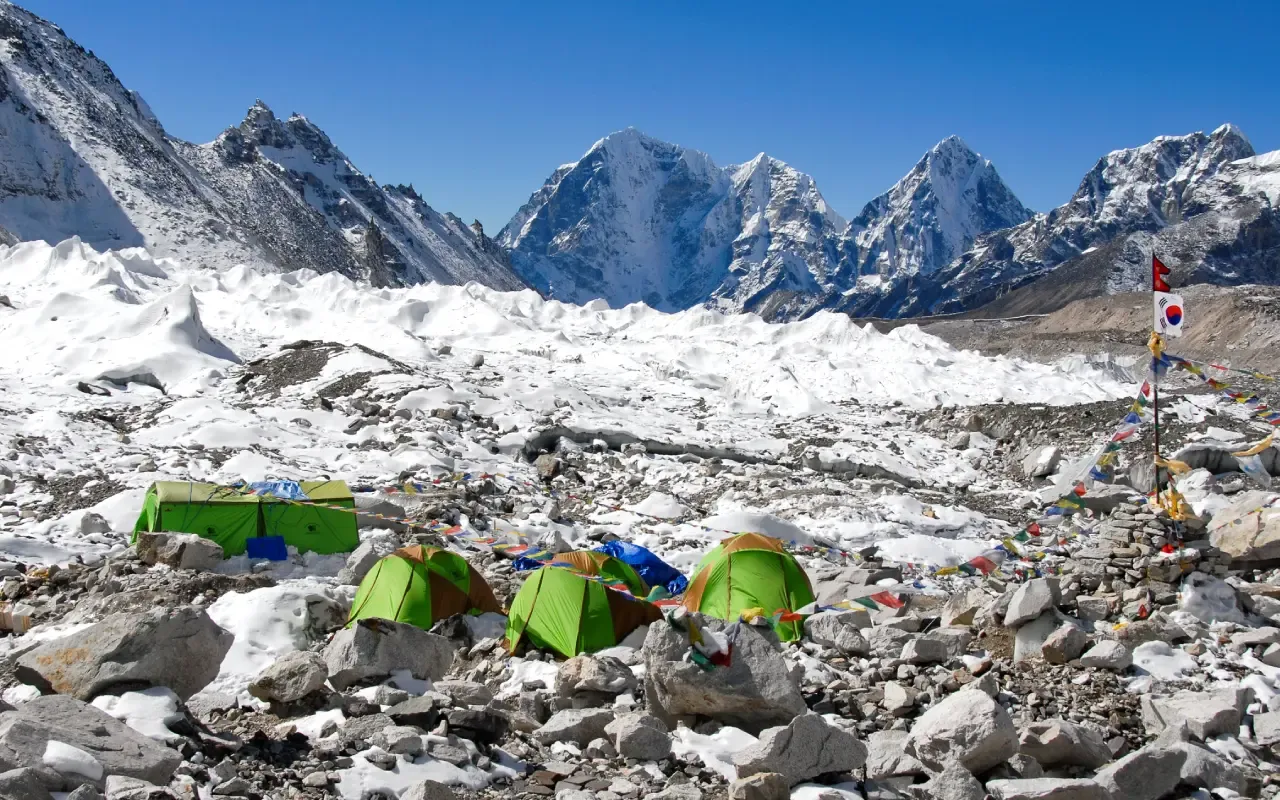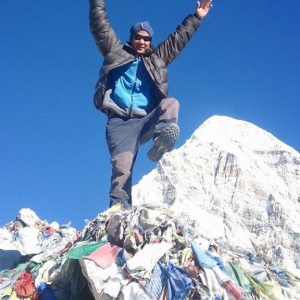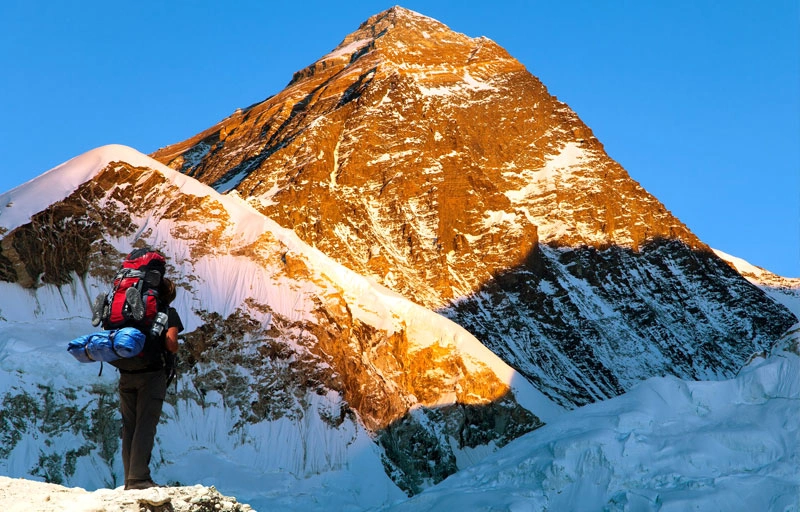How Hard is it to climb Everest?
“How Hard Is It to Climb Everest?” might be the most searched Google text; Life Himalaya has an answer for it. This blog provides an in-depth explanation of How Hard Everest is to successfully summit Everest, as well as all the trinkets involved during the Summit of the World’s Highest Peak, Mount Everest, “The Roof of the World.”
Introduction
Overview of Mount Everest?
Mount Everest, as most of us already know, is the world’s highest peak above sea level. The summit of Mount Everest is 8,848.86 meters and increasing.
Location of Mount Everest: Situated on the border of Nepal and China, Most of Mount Everest and the Summit of Mount Everest fall inside the border of Nepal.
Country: Nepal
District: Solukhumbu
National Park: (Everest) Sagarmatha National Park
Latitude and Longitude: 27.9882° N, 86.9254° E
Other Names of Everest
Sagarmatha (सगरमाथा) — In the Nepali Language, meaning “Forehead of the Sky” or “Goddess of the Sky.”
Chomolungma/ Qomolangma— In Tibetan Language, meaning “Goddess Mother of the World” or “Holy Mother.”
Why the Question “How Hard Is It to Climb Everest?” Matters
The question “How Hard Is It to climb Everest?” has many answers and various meanings. Mostly, People refer to it as “Hard” as in physical difficulty. But it is deeper than that – It symbolizes the ultimate challenge to adventure lovers worldwide. It goes beyond physical difficulty; it refers to mental challenge, ambition, risk-taking capacity, planning, technicality, financial planning and investment, time, and self-realization of the value of Climbing Everest to ourselves.
Furthermore, knowing “ How Hard is it to climb Everest?’ matters because it helps the climbers and potential climbers to appreciate the rewards of climbing the peak, knowing what factors are involved to make a single person able to reach the top of the world. It teaches how to be a responsible climber first, before you start preparing for the final push.
Understanding the Challenge
Death Zone:
Everest Death Zone is considered above 8000 meters and higher, mainly due to less oxygen, not an ideal place for camping, to make it easier, and riskier even if that is possible.
Duration and Physical Commitment
Climbing Everest is not a short adventure; it is a 60–70 day commitment. Most expeditions last around two months, including acclimatization, preparation, and weather window waiting. Climbers need to trek for weeks in harsh conditions, carrying gear, climbing technical sections, and sleeping in high camps where oxygen levels are dangerously low. The physical and mental dedication required is immense.
Climbing Seasons and Weather Extremes
The best time to climb Everest is during the pre-monsoon (April–May) and post-monsoon (September–October) seasons. These windows offer relatively stable weather and lower wind speeds. However, climbers must still endure extreme cold, sudden storms, and winds over 100 km/h. Timing the summit push within a short weather window can make or break an expedition.
The Route to the Top
The Two Main Routes – South Col (Nepal) vs. North Col (Tibet)
There are two major routes: the South Col route from Nepal and the North Col route from Tibet. The South Col is more popular, offering better logistics, experienced Sherpa support, and safer evacuation options. The North Col route is technically more challenging with harsher winds but avoids the Khumbu Icefall.
Step-by-Step Breakdown of the South Col Route (Nepal)
Base Camp (5,364 m) – The starting point of the climb.
Khumbu Icefall (5,500–6,000 m) – A dangerous maze of ice towers and crevasses.
Camp I (6,065 m) – First major acclimatization stop.
Camp II (6,400 m) – Advanced Base Camp in the Western Cwm.
Camp III (7,162 m) – On the Lhotse Face, requiring fixed rope climbing.
Camp IV (7,925 m) – South Col, the last camp before the summit.
Summit (8,848.86 m) – The final push through the Balcony, South Summit, Hillary Step, and summit ridge.
Iconic Landmarks – Khumbu Icefall, Camp 4, Hillary Step
The Khumbu Icefall is one of the most dangerous sections, where ice collapses are frequent. Camp 4 on the South Col marks the entry into the ‘Death Zone’. The Hillary Step, once a bottleneck, remains an iconic feature close to the summit.
How the Route Affects Difficulty
The South Col route is longer but offers better support, while the North Col has harsher winds and technical challenges. The choice of route significantly affects the overall difficulty and risks.

Physical Fitness Requirements
Required Endurance and Strength Levels
Climbers must have high levels of cardiovascular endurance, leg strength, and stamina. Training should simulate long days of trekking with heavy packs in low-oxygen conditions.
As well as the breathing techniques of long and controlled breaths under extensive climbs and stress.
Recommended Training Plan for Everest Expedition (At least 12+ Months Before the Climb)
A year-long plan should include endurance training, strength conditioning, altitude practice, and technical climbing. Regular hiking, mountaineering courses, and multi-day expeditions are essential.
We would also recommend seeking guidance from a cardiovascular medical specialist and trainer for constructing the plan and monitoring the progress throughout the year
Altitude Acclimatization and Its Importance
Proper acclimatization prevents altitude sickness. The climb is staged with rest days at key points to allow the body to adjust. Without acclimatization, the risks of AMS, HAPE, and HACE increase dramatically.
Common Health Risks: HAPE, HACE, Frostbite
High-Altitude Pulmonary Edema (HAPE), High-Altitude Cerebral Edema (HACE), and frostbite are among the biggest threats. Knowledge of symptoms and immediate response is vital for survival.
Mental Preparation
Coping with Stress and Fear at High Altitude
Mental toughness is as important as physical strength. Climbers face isolation, fear of avalanches, and constant uncertainty. Developing coping strategies is essential.
Sleep Deprivation and Decision Fatigue
Sleep is often difficult above 7,000 meters. Combined with fatigue, this can impair judgment during critical moments.
Staying Focused During Weeks of Expedition
Patience and resilience are necessary to endure weeks of waiting at Base Camp for suitable weather.
Stories of Mental Grit from Past Climbers
Many successful climbers credit determination and focus as the deciding factors in reaching the summit despite extreme challenges.
Technical Skills Needed
Basic Mountaineering Skills You Must Have
Before attempting Everest, climbers must already know the basics of mountaineering. This includes walking safely with crampons, handling an ice axe, clipping into fixed ropes, and moving efficiently on steep snow slopes. These skills are normally learned on smaller mountains. Without them, the climb becomes much harder and unsafe.
Now, it is also mandatory to climb 6000 meter peaks and 7000meter peak before climbing Mount Everest.
Ice Climbing, Crampons, and Rope Work
Everest requires solid ice climbing skills, especially when moving through the Khumbu Icefall and steep icy sections. Crampons are essential for grip on frozen terrain, while rope techniques are needed for ascending and descending fixed lines. A climber must feel confident in using these tools because mistakes in these places can be deadly.
Crossing Ladders in the Khumbu Icefall
One of the most famous and nerve-wracking parts of the climb is crossing aluminum ladders placed across deep crevasses in the Khumbu Icefall. Climbers need balance, courage, and trust in their equipment. Many first-timers find this experience terrifying, but with practice and guidance, it becomes manageable.
Self-Rescue and Crevasse Safety
Climbers must be prepared for emergencies. Knowing how to pull yourself out of a crevasse or help a teammate in trouble is critical. Rescue knowledge and glacier travel safety are not just optional—they can make the difference between life and death on Everest.
The Majestic View from Everest Base Camp (EBC)The Role of Sherpas & Guides
Who Are the Sherpas?
Sherpas are an ethnic group from Nepal, famous for their strength and skill at high altitude. For decades, they have been the backbone of Everest expeditions, carrying loads, fixing ropes, and guiding climbers. Their knowledge of the mountains and endurance at altitude is unmatched.
How Guides Reduce the Difficulty
Professional guides and Sherpas make Everest more achievable for climbers. They set up camps, manage logistics, and ensure safety on dangerous sections. Without their help, many climbers would struggle to even reach Camp 2, let alone the summit.
Life Himalaya Trekking’s Approach to Client Safety
At Life Himalaya Trekking, client safety always comes first. We provide experienced guides, strong Sherpa support, and the best equipment. Our strategy is to make sure climbers are well-prepared, well-acclimatized, and supported at every step of the journey.
Why Climbing Everest Without Sherpa Support Is Extremely Risky
Although a few elite climbers have climbed Everest without Sherpa help, for most people, it is extremely dangerous. Carrying heavy loads, setting up tents, and managing oxygen alone at such altitude drains energy. Sherpas reduce the risk and increase the chances of a safe and successful summit.
Logistical and Financial Challenges
Expedition Duration and Scheduling
Climbing Everest is not a short adventure—it is a 6–9 week commitment from arrival in Kathmandu to the final return. The extended duration is necessary for acclimatization, weather windows, and logistical setups along the route. Climbers must be prepared to spend weeks at base camp, waiting for favorable conditions before moving higher. This patience and flexibility are just as important as strength on summit day.
Costs of Climbing Everest – Permit to Gear
The financial challenge of climbing Everest is as daunting as the physical one. A climbing permit from the Nepalese government alone costs around USD 11,000- 15,000 per person. In addition, climbers must budget for guide services, Sherpa support, oxygen cylinders, high-altitude gear, travel insurance, and international flights. In total, a standard Everest expedition can range from USD 40,000 to USD 70,000 depending on the level of support and luxury chosen. Life Himalaya Trekking offers transparent pricing and ensures clients understand exactly where their investment goes.
Managing Supplies and Oxygen Bottles
Logistics on Everest are highly complex. Every cylinder of supplemental oxygen must be carried up the mountain by Sherpas and carefully placed at strategic camps. Food, fuel, tents, and medical supplies also need to be transported, often requiring multiple rotations by the support team. Without precise planning, climbers may run short of essential supplies during critical moments. Professional trekking companies handle this with military-like precision, making sure climbers have everything they need at the right time and place.
The Importance of a Trusted Trekking Company
Choosing the right trekking company is maybe the single most important decision a climber makes before attempting Everest. A trusted operator provides experienced guides, skilled Sherpas, high-quality equipment, and a strong safety culture. Companies with a proven track record, like Life Himalaya Trekking, not only increase chances of summit success but also minimize risks in emergencies. Climbers are entrusting their lives to their chosen team, and reliability is non-negotiable at this level of adventure.

How Life Himalaya Trekking Prepares You for Everest
Our Pre-Climb Training Support
Life Himalaya Trekking provides personalized pre-climb support to make sure you are physically and mentally ready for Everest. We guide clients with step-by-step fitness plans for months, including hiking with heavy backpacks, strength exercises, and cardio training. We also provide technical climbing practice and tips for using crampons, ice axes, and ropes. For those who need extra guidance, we recommend smaller peaks in Nepal to gain high-altitude experience before the Everest expedition.
Safety Protocols and Risk Management
Safety is our top priority. Our team monitors each climber’s health at every stage, using pulse oximeters and regular check-ins. We carry medical kits, oxygen backups, and satellite phones for emergencies. We plan acclimatization carefully to reduce the risk of altitude sickness and strictly follow weather forecasts to avoid dangerous conditions. Every step of your journey is designed to minimize risk and maximize safety.
Use of Experienced Guides and Support Staff
Our Sherpas and guides are highly trained and have years of Everest experience. They set up camps, carry supplies, fix ropes, and guide climbers safely through dangerous sections. Their knowledge of the mountain and high-altitude conditions ensures that even difficult terrain is manageable. With their support, climbers can focus on conserving energy and following instructions for a successful summit.
Our Success Rate and Client Testimonials
Life Himalaya Trekking has a high summit success rate thanks to meticulous planning, experienced guides, and strong support systems. Our clients often praise the professionalism of our team, the quality of our equipment, and the care given to acclimatization and safety. Many climbers return not only with the achievement of reaching the summit but also with unforgettable memories of a safe and well-supported journey.





